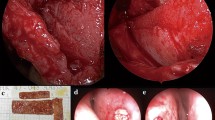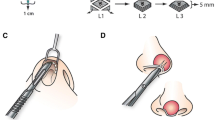Abstract
Background
This study aimed to evaluate a surgical technique used for patients requiring revision rhinoplasty to reestablish their ethnic identity.
Methods
A retrospective review involved 29 patients who underwent revision rhinoplasty to reestablish their ethnic identity using residual septal cartilage and porous polyethylene implants. The follow-up period ranged from 6 month to 7 years.
Results
For all patients undergoing revision rhinoplasty, multiple porous polyethylene implants were used to reestablish ethnic identity and to restore nasal function. Implant extrusion developed in one (3.4%) of the 29 patients. There were no cases of postimplant infection.
Conclusions
In our experience, patients who feel they have lost their ethnic identity after primary rhinoplasty tend to have overresected dorsal cartilage and bone and overresected tip cartilages. The use of multiple porous polyethylene implants in revision rhinoplasty to restore ethnic identity can provide the necessary grafting material needed for reconstruction. Many grafting options are available. According to our experience, porous polyethylene provides safe, effective, and reliable results.




Similar content being viewed by others
References
Choe KS, Sclafani AP, Litner JA, Yu GP, Romo T: The Korean American face. Arch Facial Plast Surg 6:244–252, 2004
Constantino PD, Friedman CD, Lane A: Synthetic biomaterials in facial plastic and reconstructive surgery. Facial Plast Surg 9:1–15, 1993
Daniel RK: Aesthetic plastic surgery rhinoplasty. Little Brown: Boston, p. 466, 1993
Farkas LG, Hrecko TA, Kolar JC, Monro IR: Vertical and horizontal proportions of the face in young adult North American Caucasians: Revisions of neoclassical canons. Plast Reconstr Surg 75:328–338, 1985
Gruber RP, Pardun J, Wall S: Grafting the nasal dorsum with tandem ear cartilage. Plast Reconstr Surg 112:1110–1122, 2003
Gunter JP, Rohrich RJ: Augmentation rhinoplasty: Dorsal onlay grafting material using autogenous septal cartilage. Plast Reconstr Surg 89:39–45, 1990
Jeffries JM, Dibernardo B, Rauscher GE: Computer analysis of the African American face. Ann Plast Surg 34:318–322, 1995
Milgrim LM, Lawson E, Cohen AF: Anthropometric analysis of the female Latino nose. Arch Otolaryngol Head Neck Surg 122:1079–1086, 1996
Milward TM: The fate of silastic and vitrthene nasal implants. Br J Plast Surg 25:276–278, 1972
Papadopulos A: 19 Years experience in Silastic implants in the nose: 17 Golden rules to be followed. I.S.A.P.S. 14th Congress, Sao Paulo, Brazil, 1997
Porter JP, Olson KL: Anthropometric facial analysis of the African American woman. Arch Facial Plast Surg 3:191–197, 2001
Romo T: Revision rhinoplasty: A facial plastic surgeon’s perspective. In: Romo T, Millman A (eds) Aesthetic plastic surgery. Thieme: New York, 129–152, 2000
Romo T, McLaughlin L, Levine J, Sclafani AP: Nasal implants: Autogenous, semisynthetic, and synthetic. Facial Plast Surg Clin North Am 10:155–166, 2002
Romo T, Sclafani AP, Sabini P: Reconstruction of the major saddle nose deformity using composite allo-implants. Facial Plast Surg 14:151–157, 1998
Romo T, Sonne J, Choe KS, Sclafani AP: Revision rhinoplasty. Facial Plast Surg 19:299–307, 2003
Rubin JP, Yaremchuk MJ: Complications and toxicities of implantable biomaterials used in facial reconstructive and aesthetic surgery: A comprehensive review of the literature. Plast Reconstr Surg 100:1336, 1997
Sclafani AP, Romo T: Biology and chemistry of facial implants. Facial Plast Surg 16:3–6, 2000
Sclafani AP, Romo T, Sliver L: Clinical and histological behavior of exposed porous high-density polyethylene implants. Plast Reconstr Surg 99:41–50, 1997
Stucker FJ: Non-Caucasian rhinoplasty and adjunctive reduction cheiloplasty. Otolaryngol Clin North Am 20:877-894, 1987
Wellisz T: Clinical experience with the Medpor porous polyethylene implant. Aesth Plast Surg 17:339–344, 1993
Wellisz T, Kanel G, Anooshian RV: Characteristics of tissue response to Medpor porous polyethylene implants in the human facial skeleton. J Long-Term Effect Med Implants 3:223–235, 1993
Author information
Authors and Affiliations
Corresponding author
Rights and permissions
About this article
Cite this article
Romo, T., Kwak, E.S. & Sclafani, A.P. Revision Rhinoplasty Using Porous High-Density Polyethylene Implants to Reestablish Ethnic Identity. Aesth Plast Surg 30, 679–684 (2006). https://doi.org/10.1007/s00266-006-0049-0
Published:
Issue Date:
DOI: https://doi.org/10.1007/s00266-006-0049-0




